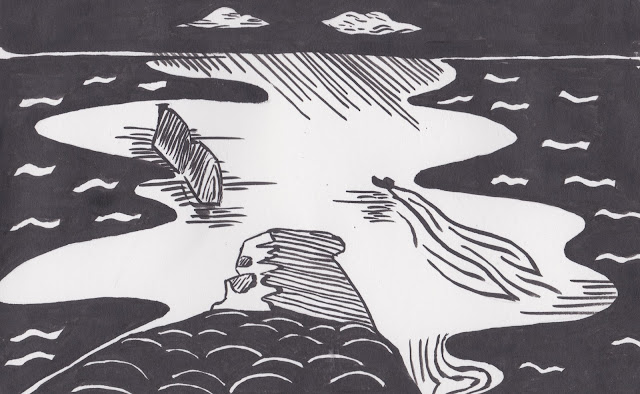Eric Fraiser
Eric Fraser was born in Westminster, London on 11 June 1902. From 1913 to 1919, he was educated at Westminster City School and attended Walter Sickert’s evening classes at Westminster School of Art. Then, in 1919, he won a scholarship to Goldsmiths’ College School of Art. There he studied under the Headmaster, Francis Marriott (etching, aquatint and mezzotint), and also Clive Gardiner (drawing and painting), Harold Speed (painting), E J Sullivan (book illustration and lithography) and Alfred Taylor (commercial art).
In 1926, Fraser began to draw for The Radio Times, a collaboration that would last until his death, giving the magazine its visual identity along with many other artists. Fraser’s style was founded upon a thorough knowledge of the history of printing methods, which he mainly reproduced in pen and ink; traditional images were combined with mechanistic and scientific motifs to create a Modernist view of the past. He produced drawings for a number of other magazines, including fashion plates for the British version of Harper’s Bazaar, from its inception in 1929. His wide- ranging work for advertising is epitomised by his invention, in 1931, of ‘Mr Therm’ for the Gas, Light and Coke Company.
 |
| Figure 1 - BBC Radio Times Coronation number for Queen Elizabeth II - artwork by Eric Fraser |
Fraser died at home on 15 November 1983 and was buried next door at St Mary the Virgin. His work is now represented in the collections of the V&A.
Eric Fraiser is well known for his monotone working methods with a lot of his pieces focusing strongly on pen and ink technique. They strongly focus on contrast between the negative and positive space and create the feel that they are actually wood cuts and not pen and ink drawings. This was due to his practie of history printing methods.
 |
| Figure 2 - Landscape by Eric Fraiser |
 |
| Figure 3 - Illustrations for 'The Hobbit' |
 |
| Figure 4 - Own photography of The Needle - Isle of Wight |
 |
| Figure 5 - Methodologies applied to own photo. |
Here I have explored the idea of monotone, positive and negative space. Straight lines, the clouds are similar to other pieces of his work and I feel the image successful explores his methodologies.
Image references:
- Figure 1 - BBC radio times Coronation number for Queen Elizabeth II - artwork by Eric Fraser (2016)
- Figure 2 - Beard, P. and profile, V. my complete (1951) More Eric Fraser.
- Figure 3 - Harris and profile, V. my complete (2013) ‘The Hobbit’, JRR Tolkien (first published in 1937 by George Allen & Unwin). Illustrations by Eric Fraser.
Bibliography
- 2010, C.B.L. (2010) ERIC FRASER - original artwork for sale. Available at: http://www.chrisbeetles.com/artists/fraser-eric-fsia-1902-1983.html# (Accessed: 15 October 2016).
- BBC radio times Coronation number for Queen Elizabeth II - artwork by Eric Fraser (2016) Available at: https://www.flickr.com/photos/36844288@N00/4298409403 (Accessed: 15 October 2016).
- Beard, P. and profile, V. my complete (1951) More Eric Fraser. Available at: http://buttes-chaumont.blogspot.co.uk/2008/02/more-eric-fraser.html (Accessed: 15 October 2016).
- Harris and profile, V. my complete (2013) ‘The Hobbit’, JRR Tolkien (first published in 1937 by George Allen & Unwin). Illustrations by Eric Fraser. Available at: http://picturesfromanoldbook.blogspot.co.uk/2010/10/hobbit-jrr-tolkien-first-published-in.html (Accessed: 15 October 2016).
No comments:
Post a Comment